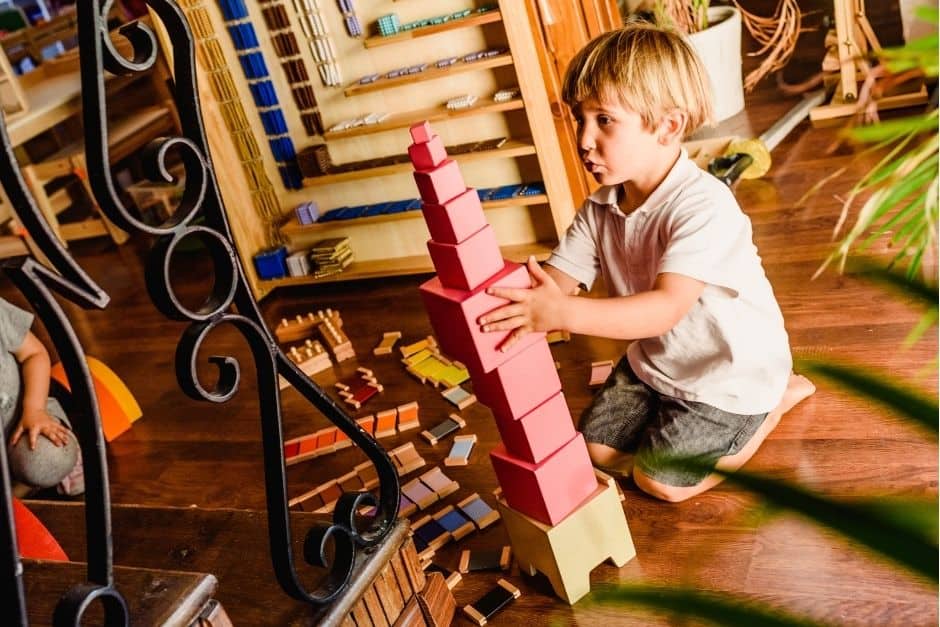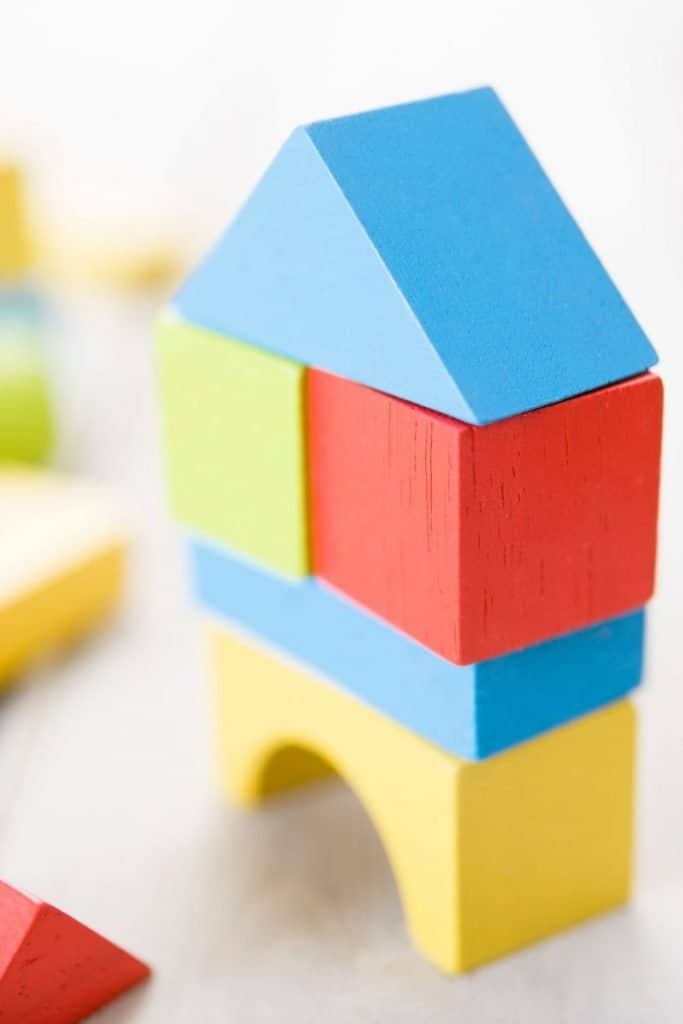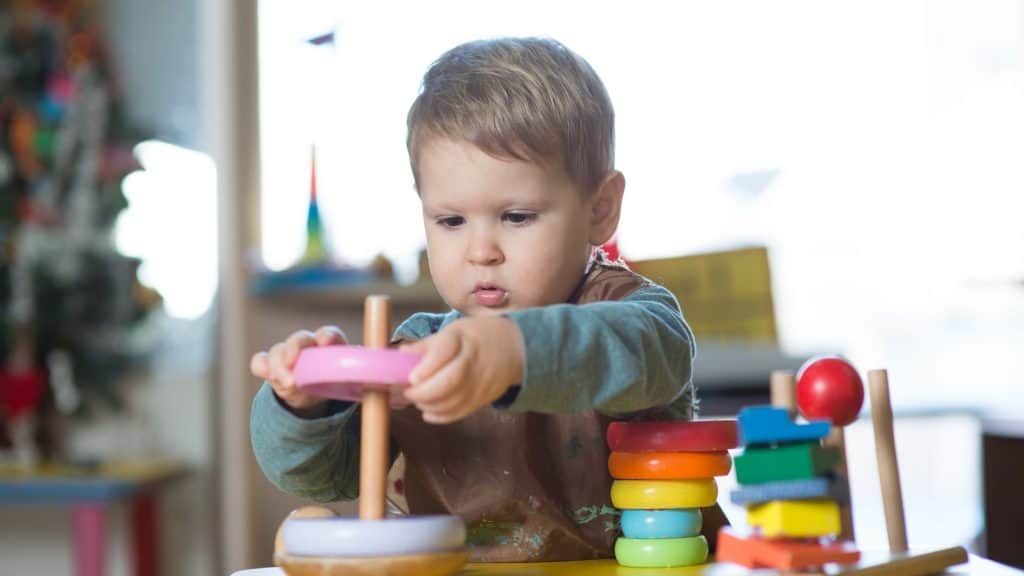The ability of a toddler to develop the skill of stacking toys or blocks is an interesting developmental milestone. Parents may notice their children attempting to stack toys and objects of all sorts and therefore wish to find specific open-ended toys for toddlers that will foster stacking and building skills.
There are many different options on the market for stacking toys for toddlers. Some are marketed as Montessori toys, even though stacking toys in and of themselves are not necessarily part of the Montessori approach to learning and development. Montessori or not, stacking is the type of open-ended play that really helps develop important skills.
Different types of stacking toys include wooden stacking toys, blocks, nesting cups, stacking rings, or even smooth and flat rocks.
In this article, we will explore the benefits of stacking toys for toddlers and considerations for parents in purchasing stacking toys, along with some helpful toy recommendations.
Why do toddlers stack toys?
Toddlers often start showing the interest and ability to manipulate stacking toys around 14 months of age, right around the time they start experimenting with different ways to organize their toys.
This developmental behavior as a whole points to a desire by the child to order and control his environment and the objects within it. Stacking toys also acts as an experiment as a child starts to master fine motor skills related to matching sizes and balancing.
And of course, there is the delight a child shows when he knocks down the stack of toys to see what happens.

Why are stacking toys good for toddlers?
Stacking toys help toddlers develop very specific motor skills and visual perception that will, surprisingly, help with the development of other organizational skills as a child moves toward his preschool years.
Some of the important skills fostered by stacking toys include:
- hand-eye coordination
- the ability to grasp objects of different sizes
- visual discernment of sizes and shapes
- stacking (balancing) or threading objects
Depending on the type of stacking toys available for a child, they may also help develop his ability to distinguish and sort different colors and even the development of pre-writing skills, like the pincer grip required to properly hold a pencil.
Sorting open-ended toys and stacking toys also helps foster skills related to problem-solving, number sense, and patterns.

Different Types of Stacking Toys
There are a number of different types of stacking toys available, and all are beneficial open-ended toys to make available for your toddler.
- Wooden stacking toys, as a whole, encompass any wooden toy that is designed to be placed one on top of another to build a tower. Usually these are in the shape of cubes and cylinders of different sizes, and may or may not be made in different colors. Wooden stacking toys are often made available as part of Montessori wooden toy collections.
- Blocks, the quintessential open-ended toy for toddlers and young children, are simple but varied in shape and size. A child can experiment with how to stack and balance, even experimenting with what happens when he places a block across the rounded side of a cylindrical block or the apex of a triangular block.
- Nesting cups are versatile stacking toys that provide a two-fold benefit to toddlers. When flipped upside-down, the cups can be stacked in the same way as wooden stacking toys or blocks, with smaller blocks placed on top of larger blocks to make a tower. When placed with the open end up, nesting cups help a child practice the skill of inserting one object into another.
- Stacking rings involve a series of rings, preferably wooden but often also available in plastic or stuffed fabric, of decreasing size that are threaded onto a central peg. This type of toy requires a slightly different form of hand-eye coordination than toys that stack one on top of another, as the child must be able to center the peg in the middle of the ring.
- Other stacking shapes may be more difficult to find for purchase, but sets of varying geometric shapes are available. Other good examples include round, flat rocks of different sizes or even chunks of wood or mulch from the yard that a child can experiment with.
What to Consider in Stacking Toys
When deciding on a set of stacking toys for toddlers, there are several things to consider.
Although stacking toys are not definitively considered Montessori toys, they do align well with Montessori principles. As such, wooden stacking toys are a better choice for toddlers over those made of plastic, as the natural material of wood is warm and inviting to the touch.
Whatever stacking toys you, as a parent, ultimately choose, the set should encompass two primary purposes.
- In the first stage of development, a child should learn to stack one toy on top of another.
- In the second stage of development, a child should learn to form a tower, starting with the largest toy on the bottom and progressing to the smallest toy on top.
There should also be some simplicity in the stacking toy, so that the child is only focusing on one aspect of play. For example, if the goal is to work on stacking progressively smaller blocks on top of each other, a set that is all one color is preferable over a multicolored set. Alternately, if the toy has more than one varying aspect, such as sorting size as well as color, the parent should work with the child to focus only on one skill at a time.

The best stacking toys for toddlers
Here are some of our favorite stacking toys for toddlers.
Melissa & Doug Geometric Stacker
This stacking toy from Melissa & Doug is a high quality wooden stacking toy with three pegs, upon which a child can thread three different sets of colorful geometric shapes. In addition to practice with stacking and threading, a child can also learn to identify and sort basic shapes and colors. This toy is recommended for children ages 2 through 4.
Lewo Wooden Rainbow Stacking Game
A unique set of triangular, multicolored blocks, the Lewo Wooden Rainbow Stacking Game has many options for open-ended play and methods of stacking and nesting. The well-made pieces come in a variety of sizes to entice creative experimentation and can also be used to promote the development of visual discernment of colors or sizes, patterns, and orientation.
Large Cubby Block Storage Unit with Rolling Casters
While not a stacking toy, this storage unit provides the perfect place to store sets of stacking toys for easy accessibility by a child. Made of wood and designed with eight open cubbies at child height, this unit aligns well with the Montessori principle of independent access to play materials.
Dreampark Wooden Rainbow Stacking Toy
A classic-style rainbow stacking toy, the Dreampark Wooden Rainbow Stacking Toy helps a child practice nesting by size and color, lining up by size, balancing the arcs on top of one another, and boundless open-ended play.
Green Toys Stacking Cups
These stacking cups by Green Toys are not made of wood, but rather 100% recycled plastic milk jugs. (Green Toys works to create a variety of toys made from 100% recycled plastics as a way to reduce greenhouse gas emissions and save energy.) Shaped like stars, this set of six colorful cups can be used to practice stacking, nesting, pouring, or sorting.
Fat Brain Toys Spoolz Stacking Toy
This colorful stacking toy from Fat Brain Toys presents a unique shape that entices and challenges children to try different ways of stacking. Younger toddlers will work on stacking the flat sides, while older toddlers and preschoolers will experiment with stacking the rounded sides, having to switch the orientation of the spools with each level. The large size and shape make the Spoolz easy for even the littlest hands to grasp, and the plastic is 100% BPA-free.
Manhattan Toy Boom Shock-A-Locka Wooden Stacking Toy for Toddlers
The Boom Shock-A-Locka Wooden Stacking Toy from Manhattan Toy is comprised of five wooden pieces, made with water-based, non-toxic finish and paints, that thread onto a central peg. There is no one correct way to stack this toy, and a child can be as creative and experimental as he wants. Designed for toddlers starting at one year of age, this toy promotes hand-eye coordination, problem solving, and spatial perception.
Fat Brain Toys Tobbles Neo
Another selection from Fat Brain Toys, the Tobbles Neo helps your child work on coordination, spatial reasoning, and creative thinking. Each physics-defying heavy-duty plastic cup can be used to explore balance, stacking, nesting, and even spinning. Another great aspect of this unique toy is that it can be introduced to babies as young as six months old!
Vikki is the creator of Totsgo and the mother of two children. She is a passionate mother who enjoys assisting other parents.
